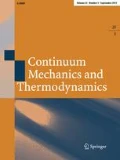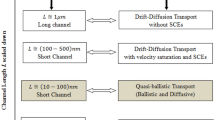Abstract
A nanoscale double-gate MOSFET is simulated with an energy-transport subband model for semiconductors formulated starting from the moment system derived from the Schrödinger–Poisson–Boltzmann equations. The system is closed on the basis of the maximum entropy principle and includes scattering of electrons with acoustic and non-polar optical phonons. The proposed expression of the entropy combines quantum effects and semiclassical transport by weighting the contribution of each subband with the square modulus of the envelope functions arising from the Schrödinger–Poisson subsystem. The simulations show that the model is able to capture the relevant confining and transport features and assess the robustness of the numerical scheme.
Similar content being viewed by others
References
Datta S.: Quantum Phenomena, Modular Series on Solid State Devices. vol. 8. Addison-Wesley Publishing, Reading (1989)
Lundstrom M.: Fundamentals of Carrier Transport. Cambridge University Press, Cambridge (2000)
Wang J., Polizzi E., Lundstrom M.: A three dimensional quantum simulation of silicon nanowire transistors with the effective-mass approximation. J. Appl. Phys. 96, 2192–2203 (2004)
Chen D., Wei G.-W.: Modeling and simulation of electron structure, material interface and random doping in nano-electronic devices. J. Comput. Phys. 229, 4431–4460 (2010)
Markowich P., Ringhofer C.A., Schmeiser C.: Semiconductor Equations. Springer, Wien (1990)
Jüngel A.: Transport Equations for Semiconductors, Lecture Notes in Physics, vol. 773. Springer, Berlin (2009)
Romano V.: Quantum corrections to the semiclassical hydrodynamical model of semiconductors based on the maximum entropy principle. J. Math. Phys. 48, 123504 (2007)
Fischetti M.V.: Master equation approach to the study of electronic transport in small semiconductor devices. Phys. Rev. B 59, 4901–4917 (1999)
Ando T., Fowler A.B., Stern F.: Electronic properties of two-dimensional systems. Rev. Mod. Phys. 54, 437–672 (1982)
Polizzi E., Ben Abdallah N.: Self-consistent three dimensional models for quantum ballistic transport in open systems. Phys. Rev. B 66, 245301-1–245301-9 (2002)
Polizzi E., Ben Abdallah N.: Subband decomposition approach for the simulation of quantum electron transport in nanostructures. J. Comput. Phys. 202(1), 150–180 (2004)
Galler, M., Schuerrer, F.: A deterministic solver to the Boltzmann-Poisson system including quantization effects for Silicon-MOSFETs. In: Progress in Industrial Mathematics at ECMI 2006, Series: Mathematics in Industry, pp. 531–536. Springer, Berlin (2008)
Ben Abdallah N., Caceres M.J., Carrillo J.A., Vecil F.: A deterministic solver for a hybrid quantum-classical transport model in nanoMOSFETs. J. Comput. Phys. 228, 6553 (2009)
Majorana A., Muscato O., Milazzo C.: Charge transport in 1D silicon devices via Monte Carlo simulation and Boltzmann-Poisson solver. COMPEL 23(2), 410–425 (2004)
De Falco C., Gatti E., Lacaita A., Sacco R.: Quantum-corrected drift-diffusion models for transport in semiconductor devices. J. Comput. Phys. 204, 533 (2004)
Ben Abdallah N., Méhats F., Vauchelet N.: Diffusive transport of partially quantized particles: existence, uniqueness and long-time behaviour. Proc. Edinb. Math. Soc. 2(49), 513–549 (2006)
Mascali G., Romano V.: Hydrodynamic subband model for semiconductors based on the maximum entropy principle. IL NUOVO CIMENTO 33 C, 155 (2010)
Müller I., Ruggeri T.: Rational Extended Thermodynamics. Springer Berlin Heidelberg, New York (1998)
Jou D., Casas-Vazquez J., Lebon G.: Extended Irreversible Thermodynamics. Springer, Berlin (1993)
Titchmarsh E.C.: Elgenfunction Expansions Associated With Second Order Differential Equations. Clarendon Press, Oxford (1946)
Jaynes E.T.: Information theory and statistical mechanics. Phys. Rev. B 106, 620 (1957)
Wu N.: The Maximum Entropy Method. Springer, Berlin (1997)
Anile A.M., Romano V.: Non parabolic band transport in semiconductors: closure of the moment equations. Cont. Mech. Thermodyn. 11, 307 (1999)
Romano V.: Non parabolic band transport in semiconductors: closure of the production terms in the moment equations. Cont. Mech. Thermodyn. 12, 31 (2000)
Mascali G., Romano V.: Simulation of Gunn oscillations with a non-parabolic hydrodynamical model based on the maximum entropy principle. Compel 24(1), 35–54 (2005)
Anile A.M., Mascali G.: Theoretical foundations for tail electron hydrodynamical models in semiconductors. Appl. Math. Lett. 14(2), 245–252 (2001)
La Rosa S., Mascali G., Romano V.: Exact maximum entropy closure of the hydrodynamical model for Si semiconductors: the 8-moment case. SIAM J. Appl. Math. 70, 710 (2009)
Mascali G., Romano V.: Hydrodynamical model of charge transport in GaAs based on the maximum entropy principle. Cont. Mech. Thermodyn. 14, 405 (2002)
Romano V.: Nonparabolic band hydrodynamical model of silicon semiconductors and simulation of electron devices. Math. Method Appl. Sci. 24, 439–471 (2001)
Mascali G., Romano V.: Si and GaAs mobility derived from a hydrodynamical model for semiconductors based on the maximum entropy principle. Phys. A 352, 459–476 (2005)
Mascali G., Romano V.: A hydrodynamical model for holes in silicon semiconductors: The case of non-parabolic warped bands. Math. Comput. Model. 53(01–2), 213–229 (2011)
Ren, Z.: Nanoscale MOSFETs: Physics, Simulation, and Design. PhD thesis, Purdue University, West Lafayette (2001)
Romano V.: 2D numerical simulation of the MEP energy-transport model with a finite difference scheme. J. Comput. Phys. 221, 439 (2007)
Degond P., Jüngel A., Pietra P.: Numerical discretization of energy-transport models for semiconductors with non-parabolic band structure. SIAM J. Sci. Comput. 22, 986–1007 (2000)
Muscato O.: The Onsager reciprocity principle as a check of consistency for semiconductor carrier transport models. Phys. A 289(3–4), 422–458 (2001)
Author information
Authors and Affiliations
Corresponding author
Additional information
Communicated by Henning Struchtrup.
Rights and permissions
About this article
Cite this article
Camiola, V.D., Mascali, G. & Romano, V. Numerical simulation of a double-gate MOSFET with a subband model for semiconductors based on the maximum entropy principle. Continuum Mech. Thermodyn. 24, 417–436 (2012). https://doi.org/10.1007/s00161-011-0217-6
Received:
Accepted:
Published:
Issue Date:
DOI: https://doi.org/10.1007/s00161-011-0217-6




